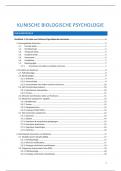Resume
Samenvatting klinisch biologisch psychologie (2024)
- Établissement
- Vrije Universiteit Brussel (VUB)
Dit is een uitgebreide samenvatting van het vak klinisch biologische psychologie gegeven in de eerste master klinisch psychologie aan de VUB. De samenvatting omvat alle informatie van de slides, lesnota's en afbeeldingen.
[Montrer plus]



